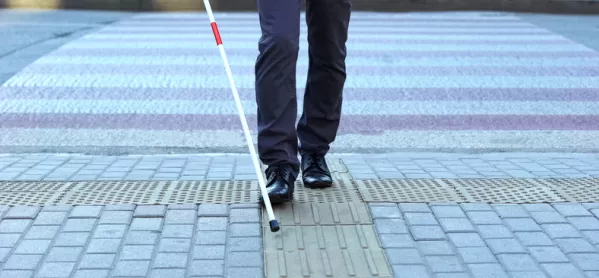Teaching remotely has brought a series of challenges for teachers across the UK, but also for many learners. Online chat rooms and video conferencing have with no doubt managed to keep many students of all ages engaged and educated, but how well do they cater for the needs of the partially sighted or blind?
I am an anatomy and physiology lecturer and I also teach sports massage therapy and English functional skills at Greater Brighton Metropolitan College. At GBMC, we have always used Google Classroom and Google Drive to engage learners so it was a natural progression to use Google Chat and Hangouts as the foundation of our remote teaching.
News: Nursing apprentices get green light for NHS front line
More: Thank you, teachers – you are our superheroes
Watch: Sweet online patisserie lessons for Easter
I’d like to share with you the stories of two individuals from my anatomy and physiology classes who, through slightly different approaches, we have managed to fully include in the remote teaching. Doing so has made them, me, and all the class members extremely happy. I present to you Charlie and Dave.
Charlie Parkinson
Charlie is ex-forces, he was in the 1st Battalion Kings Regiment and Royal Army Medical Core.
At the age of 33, he lost sight in left eye due to sudden glaucoma, and now he has just 5 per cent vision in his right eye. He was also diagnosed with dyslexia when joining the Royal Army Medical Core.
Charlie is keen to use the 5 per cent sight he has as much as possible. With the support of Blind Veterans UK, Charlie uses Dolphin SuperNova software on his laptop, which gives him the screen magnification he needs to be able to read.
Though Charlie is not able to join the rest of the class in the Google Chat Room for the video presentation I give once a week, we came up with a simple solution: just prior to starting my live online presentation, I give Charlie a call on his mobile and then put him on speaker phone. He is able to hear me and the rest of the class while looking at the presentation slides which I send in advance. Ask questions, answer questions, it’s all there for him.
Charlie is over the moon with this remote way of working and I have to say both myself and the rest of the class are too. With his past experience of working in the Royal Army Medical Core, he obviously has some wonderfully relevant information to share, not to mention a fantastic sense of humour and positivity. After the presentation, he receives the recording which I make available to all class members, to watch again in his own time to reinforce learning. Also, ensuring print outs are on blue paper helps him manage his dyslexia.
Charlie has one tip for teachers: “Communication. Don’t be afraid to ask what best works for the individual.”
Dave Horwood
At the age of 3, Dave lost his sight due to retinoblastoma (Rb), a rare form of cancer almost exclusively found in young children. By 4 years old he could read Braille and was able to go to a mainstream school. He studied music technology and broadcasting at the University of West London and has worked extensively in user testing for websites.
Thanks to his confidence in working with computers, Dave is able to use NonVisual Desktop Access (NVDA), a free open-source, portable screen reader for Microsoft Windows. The software allows Dave to join the rest of the class in the Google chat room for the video presentation. All chat text is translated to voice into Dave’s earphones, and having learned to touch type at a young age he is able to partake in the chat with ease. NVDA also speaks the text from pdfs, so Dave is able to pre-prepare for the presentation by reading the slides I send in advance, as well as listening to the presentation recording that I send to all of the class afterwards.
Dave is very happy with this way of learning. He is a huge asset to the class and has shown incredible determination and ability in learning the practical side of massage. He is an amazing individual.
Dave’s tip for teachers is something he’s said since he was a teenager: “Don’t worry about asking!”
Charlie and Dave hope that by sharing their stories and learning experiences they will give confidence to other teachers out there who work with the blind or partially sighted. I am indebted to both of them for helping me grow as both a teacher and a person.
Matt Phillips is a lecturer in anatomy and physiology at Greater Brighton Metropolitan College. He can be contacted on matt.phillips@gbmc.ac.uk

